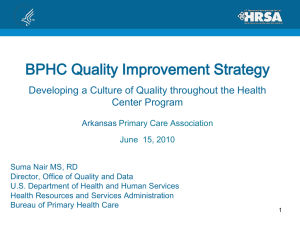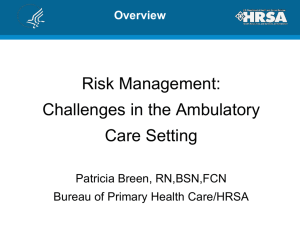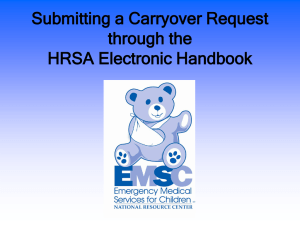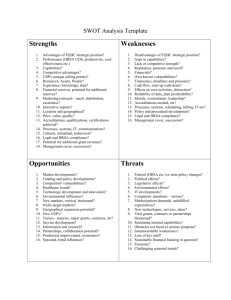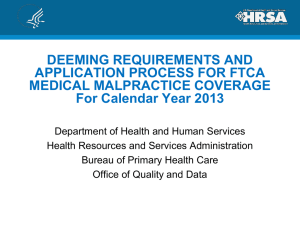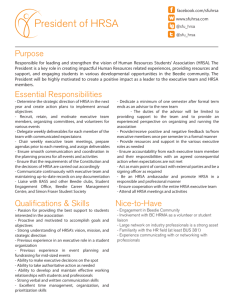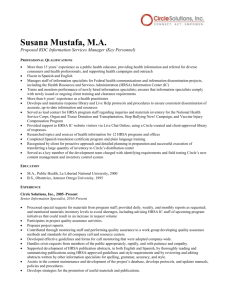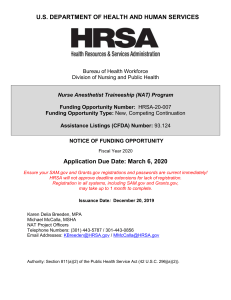Quality Improvement - Indiana Primary Health Care Association
advertisement
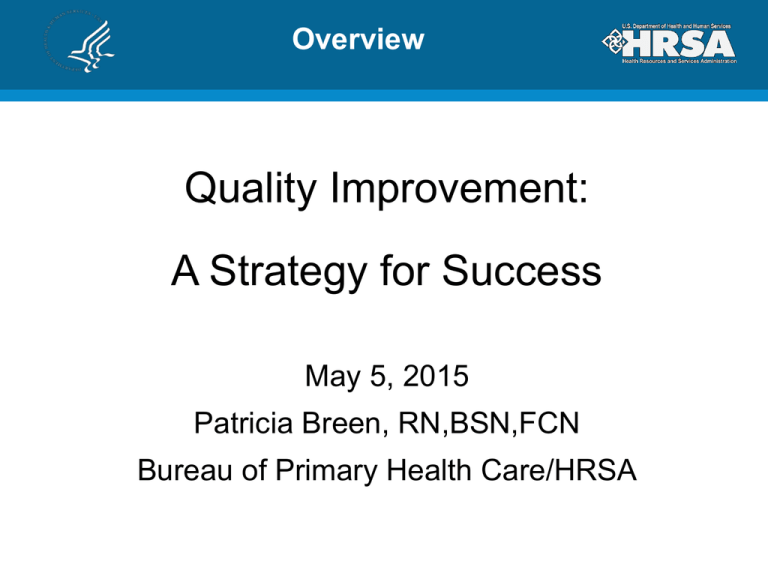
Overview Quality Improvement: A Strategy for Success May 5, 2015 Patricia Breen, RN,BSN,FCN Bureau of Primary Health Care/HRSA Learning Objectives • Name the three aims of the National Quality Strategy • Recall the six dimensions of healthcare performance • Identify components of a robust Quality Improvement (QI) Program • Identify available QI resources National Focus on Quality • Institute of Medicine report • HHS National Quality Strategy • Accreditation (TJC/AAAHC ) • Required element of Public Health Service Act Sec. 330 grants • FTCA application • NCQA Patient Centered Medical Home (PCMH) recognition • Meaningful use (HIT) • Patient awareness/satisfaction National Quality Strategy’s Three Aims 1. Better Care: Improve the overall quality of care, by making health care more patient-centered reliable, accessible, and safe. 2. Healthy People/Healthy Communities: Improve the health of the U.S. population by supporting proven interventions to address behavioral, social, and environmental determinants of health in addition to delivering higher-quality care. 3. Affordable Care: Reduce the cost of quality health care for individuals, families, employers, and government. Definition “Quality Improvement is a continuous ongoing process designed to improve patient outcomes”. (www.hrsa.gov/healthit/toolbox) Quality Improvement • Continuous proactive approach • Commitment is critical • Culture is crucial • Customer focused • Driven by data • Encompasses: • Assessing • Implementing • Evaluating Processes and Systems Six dimensions of health care performance Provides strong foundation to support the delivery of quality health care that is: • Safe • Effective • Patient-centered • Timely • Efficient • Equitable Institute of Medicine, Crossing the Quality Chasm: A New Health System for the 21st Century. March 2001. National Academies Press. Have a Plan “A Goal without a Plan is Just a Wish”. - Antoine de Saint Exuprey Components of an Integrated QI Plan Components • Mission/ Vision • Organization–wide program • Framework or model for QI activities • Measurable goals • QI processes for identification /response to problems • Periodic review of QI Plan • Risk management integration • Additional Elements Mission/ Vision • Reflects what you are trying to accomplish at an organizational level • Defines Goals/Purpose such as: Appropriate Care, Every Patient, Every Time • May incorporate providing full access to care, utilization of best practices, ensuring effective information flow, mitigating risk in a fiscally responsible manner • Delineates authority and scope Organization – wide program • Clinical director whose focus of responsibility is to support the QI/QA program • QI committee composed of cross section of staff : clinical, non-clinical, administrative • The team is critical to the development and execution of the plan • Leadership involved in QI decision making • One overall QI committee for multiple sites Framework or model for QI activities Broadly: • Assess your safety culture • Consider patient population • Develop process for collection of identified data • Use data to guide quality improvement activities Ultimately need a method to identify and define the problem, generate alternatives, select a strategy, implement a process, and evaluate the results. Data in primary care How much? • enough to direct improvement efforts without being an undue burden Why? • To understand population served • To assess whether changes made are leading to improvement in care How? • Analyze, Prioritize, Trend What ‘s next? • Impact, Monitor Model for QI activities Specifically: • Rapid cycle Improvement: Plan-Do-Study-Act (PDSA) • FADE ( focus, analyze, develop, execute/evaluate) • DMAIC (define, measure, analyze, improve, control) • FOCUS (find, organize, clarify, understand, select) • Six Sigma/ LEAN (purpose, process, people) • Expanded Chronic Care Model Measures/Benchmarks • Uniform Data System(UDS) measures • The Healthcare Effectiveness Data and Information Set (HEDIS) • National Quality Forum Performance Measures • Benchmarks (Healthy People 2020; ANA National Database of Nursing Quality Indicators) • Best Practices (ACOG, AAFP, AMA) • Databases :AHRQ’s National Health Care Quality Report; National Healthcare Disparities Report • CMS Meaningful Use Clinical Quality Measures • Consumer Assessment of Healthcare Providers and Systems (CAHPS) Goals Set SMART goals: • Specific • Measurable • Achievable • Realistic • Time-specific Set Stretch goals RM Overlap with QI A Measure of Quality: Implementing a QI/QA Program ECRI- April 2012 archived audio conference QI Processes for identification of/ response to problems •Reporting system •Patient Satisfaction Surveys •Patient/ Provider complaints Tools •Cause and Effects Diagrams/ Fishbone Charts •Flow charts •5 Whys •Root Cause Analysis (RCA) •Failure Mode Effects Analysis ( FMEA) Factors to Consider when analyzing an event •Patient Characteristics •Task Factors •Caregiver Factors •Team Factors •Work Environment Factors •Department Factors •Institutional Factors Pronovost, P. Understanding the Science of Safety. Periodic review of QI Plan •Board review and approval on a regular basis as evidenced by Board signatures or minutes •Evaluate, Integrate, Celebrate, and Disseminate Risk management Integration • Proper Credentialing and privileging • Appropriate Supervision of staff • Periodic assessment of the appropriateness of the utilization of services and the quality of services provided or proposed to be provided to individuals served by the health center • Tracking policies and procedures • Triage policies and procedures • Policies and Procedures for investigating and addressing medical malpractice claims Risk Management Process Additional Elements • Maintain confidentiality of patient records • Know and comply with state regulations • Regular QI meetings and regular reports to the Board • Document QI activities in QI committee Minutes and Board minutes o Attendees, agenda items, discussion topics, recommendations, action items, responsible parties, timeline QI + The National Quality Three Aims and Your FQHC 1. Better Care: Improve the overall quality of care, by making health care more patient-centered reliable, accessible, and safe. 2. Healthy People/Healthy Communities: Improve the health of the U.S. population by supporting proven interventions to address behavioral, social, and environmental determinants of health in addition to delivering higher-quality care. 3. Affordable Care: Reduce the cost of quality health care for individuals, families, employers, and government. ECRI Clinical Risk Management Resources • Guidance articles • Self-assessment questionnaires • Education and training tools • Toolkits • Sample policies and tools • Archived webinars • Archived Virtual Conference • E-learn continuing education • Electronic fetal monitoring online education • Biweekly E-news • Monthly Get Safe! assessment checklists • Quarterly Practice Alert! assessment tools • Quality in Action newsletter Clinical_RM_Program@ecri.org (610) 825-6000, x5200 26 General Contact Information FTCA/BPHC Help Line Phone: 1-877-974-BPHC (877-974-2742) 9:00 AM to 5:30 PM (ET) Email: BPHChelpline@hrsa.gov FTCA Website: http://www.bphc.hrsa.gov/ftca/ Contact Information Patricia M. Breen RN Public Health Analyst Bureau of Primary Health Care Office of Quality Improvement 5600 Fishers Lane, 16W61C Rockville, Maryland 20857 Phone: 301- 443-6349 Email: pbreen@hrsa.gov
